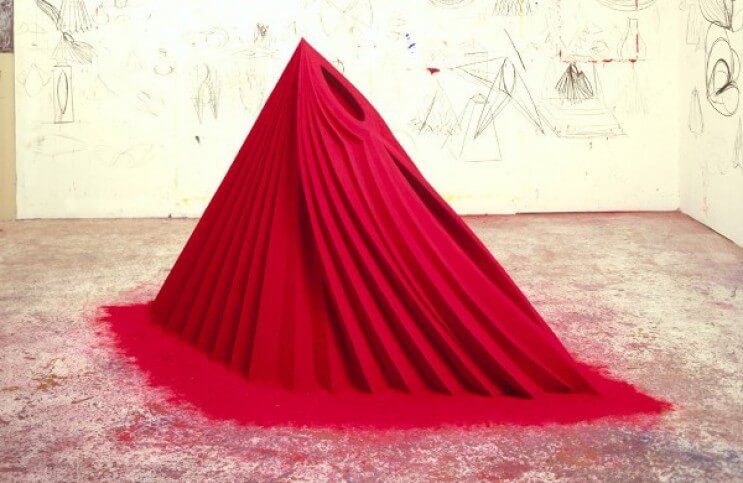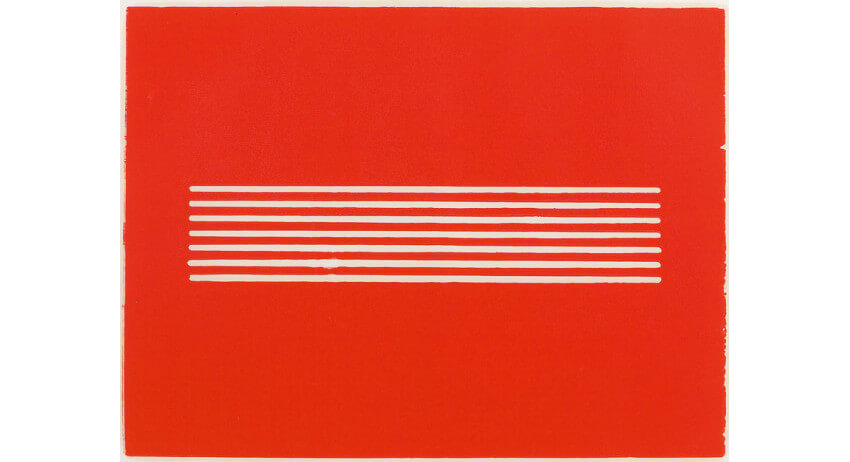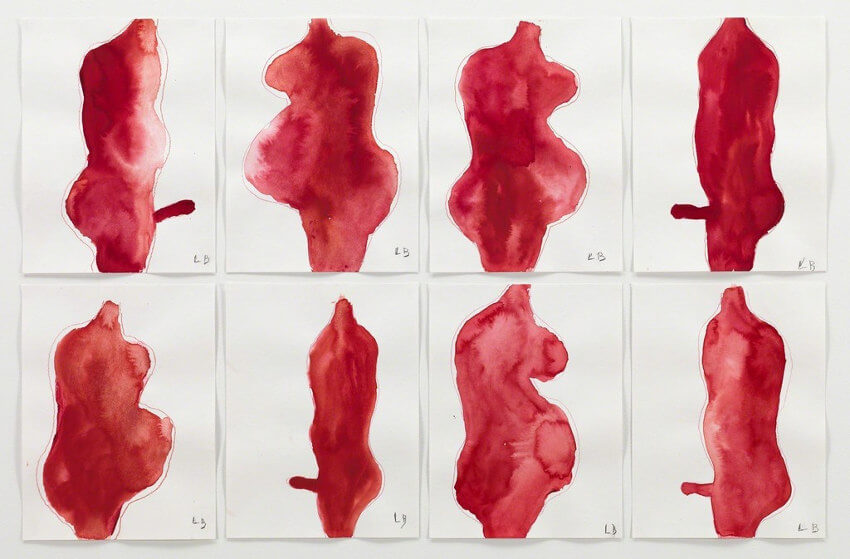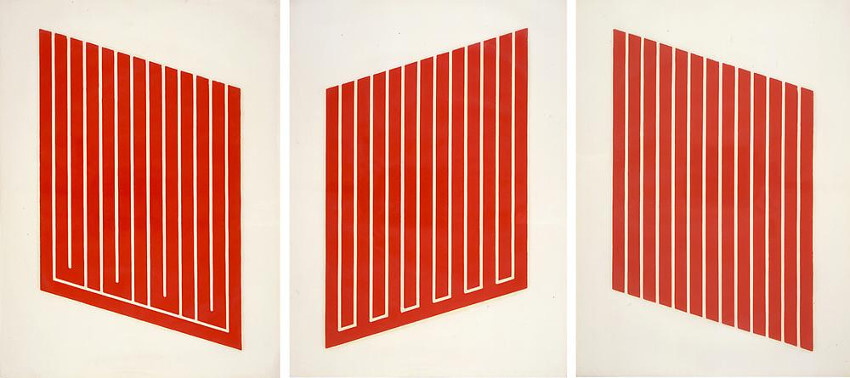
Three Masters of Red Colors in Contemporary Art
Within the spectrum of light that is visible to humans exist infinite red colors, ranging from nearly pink or nearly orange to nearly violet or nearly purple. Each variation of the color red evokes different associations in our minds and hearts. Subtle changes in hue may bring up memories, such as a bird we saw as a child, a succulent strawberry we picked fresh from a field, a sunset we witnessed on a tropical beach, or the pain of a cut on our finger. And beyond such personal associations, history has bestowed upon us cultural associations as well. Red is the color of war, the color of communism, the color of seduction, the color of warning, and the color of luck. So with so many possible associations, how can we even begin to ascertain what artists hope to suggest when choosing to work with the color red? Some answers reside in the book Chromaphilia: The Color of Art, published earlier this year by Phaidon Press. Written by former LACMA curator Stella Paul, the book takes a deep look at various colors, examining possible meanings and histories behind them by examining their use in 240 different works of art. A while back we looked at the three artists featured in the section of the book devoted to the color blue. Today we consider the three artists the book mentions as the modern and contemporary standard bearers for the color red: Donal Judd, Louise Bourgeois, and Anish Kapoor.
Red Eyes
The color red appears everywhere in our visual environment: in the sky, on the ground, in plants and animals, even on our own bodies. Its sources are as varied as the places we find it. One of the most common sources of red coloring is the element iron. The reason our blood is red is because it contains hemoglobin, a protein that contains iron and helps transport oxygen through our blood stream. The closer to the heart, the more iron-rich hemoglobin blood contains, and the darker red it appears to the eyes. Iron in its mineral form is the source of the red colors we see when we look at the soil. It can manifest as a reddish brown hue, as in amethyst crystals, or as the multitude of red hues visible in rock formations caused by iron rich ochre in the soil.
When we see the color red in plants, it is often caused by the presence of water soluble pigments known as anthocyanins. The higher the amount of these flavonoids in a certain part of the plant, the darker the pigment becomes. A plant with a lot of anthocyanins may appear so red that it turns purple or black, like a berry. One of the most common manifestations of anthocyanins is in dying leaves, which turn red as the leaves lose the green pigment that was being generated when the plant was still producing chlorophyll. When red occurs in the human body, it comes from a molecular compound related to melanin, which dictates skin color. The melanin variant that causes redness in humans is known as pheomelanin. Higher levels of it in certain areas is what is responsible for red hair and the red skin of our lips and gums.
 Donald Judd - Untitled, Woodcut, 1962, photo credits Vertu Fine Art
Donald Judd - Untitled, Woodcut, 1962, photo credits Vertu Fine Art
The Making of Red
Some of the emotional, psychological, and cultural responses humans have developed over time regarding the color red derive from the processes involved when making the pigment. One of the brightest, most vibrant red pigments used in ancient times was called vermillion. Created from the ore of mercury called cinnabar, vermillion is highly toxic. Those who mined the substance and processed for use in Roman murals or in Chinese stone wear often died from mercury poisoning. But the finished color was brilliant, and the fact that blood had been shed to acquire it only added to its prestige as a symbol of power.
But not all red pigments are deadly. Early red cave paintings were made from red pigments found readily in clay and soil. And there are a multitude of safe ways to make red dyes. The red color of antique violins often originated from a plant resin known as dragon’s blood. An ancient method of dying fabric was to use a substance known as kermes, which is derived from crushing up insects who feed on sap. And one of the most commonly used plant based red dyes throughout history was called madder, derived from the red root of the yellow madder plant. The madder plant, as is the case with many organic sources of red pigment, has not been used commercially in the production of red dye for more than a century, as it was gradually replaced by synthetic red dyes. And today, of course, almost all sources of red coloring in our culture come from synthetic sources. But those ancient associations related to the blood, sweat and tears spent to acquire the necessary ingredients to create this special pigment, nonetheless remain prominent in our collective psyche.
 Louise Bourgeois - Couple, 2009, Gouache and colored pencil on paper, photo credits Xavier Hufkens
Louise Bourgeois - Couple, 2009, Gouache and colored pencil on paper, photo credits Xavier Hufkens
Red in the Art of Donald Judd
Donald Judd devoted his artistic practice to separating art from its outside associations. In a way, it might seem quite odd that Stella Paul selected Judd as an artist to highlight when talking about the color red. After all, here we have been talking about all of the cultural and emotional baggage associated with the color, but Judd explicitly hoped that the art objects he made would contain absolutely no associations. He made objects that referenced only themselves, so would he not naturally want colors that would clarify and magnify the autonomy of his built forms? Therein lies the secret to his choice of red pigments.
For his red objects, Donal Judd used a pigment called cadmium red. Cadmium pigments are industrial products. Cadmium red is the modern replacement for the toxic vermillion that people once died mining. Judd was keen on employing industrial manufacturing processes and materials in order to eliminate any mark of the personality of the artist from his work. He wanted products that had no narrative attached, so an industrial pigment like cadmium red was ideal. But even cadmium pigments are a little harmful, and can be toxic in certain. Today, they have been all but banned from being used on things like toys, and are now being replaced by another industrial pigment called azo, which is believed to be non-toxic.
 Donald Judd - Untitled, Woodcuts in Cadmium Red, 1961-69, photo credits Vertu Fine Art
Donald Judd - Untitled, Woodcuts in Cadmium Red, 1961-69, photo credits Vertu Fine Art
Red in the Art of Louise Bourgeois
On the opposite end of the emotional spectrum from Donald Judd is Louise Bourgeois, an artist who made no secret of her desire to communicate a personal narrative through her work. Bourgeois had a famously difficult childhood, growing up in a stressful, argumentative home with a cheating father and an emotionally overwrought mother. Bourgeois confronted themes of violence, overt sexuality, infidelity, biology, fear and physical suffering through her art, and often in the process had occasion to rely on the special communicative power of the color red.
As Stella Paul points out in her book, Bourgeois once said, “Color is stronger than language. It’s a subliminal communication.” She maximized its communicative powers by incorporating it frequently in her installations called cells. Each cell Bourgeois created is a self-contained environment in which various narrative objects coexist. In a series of cells titled The Red Rooms, Bourgeois used the same dark red hue to color everything from a bedspread to giant spools of yarn and thread to domestic tools and furniture to molds of severed body parts. Assembled together in these rooms the assortment of items take on a sense of surreal melancholy, with their deep red color contributing to the feeling of powerful emotion.
 Louise Bourgeois - Red Room - Parents (detail), 1994, Wood, metal, rubber, fabric, marble, glass and mirror, "Louise Bourgeois. Structures of Existence: The Cells" at Guggenheim Museum Bilbao, Photo: Maximilian Geuter © The Easton Foundation / VEGAP, Madrid
Louise Bourgeois - Red Room - Parents (detail), 1994, Wood, metal, rubber, fabric, marble, glass and mirror, "Louise Bourgeois. Structures of Existence: The Cells" at Guggenheim Museum Bilbao, Photo: Maximilian Geuter © The Easton Foundation / VEGAP, Madrid
Red in the Art of Anish Kapoor
Like Bourgeois, Anish Kapoor is eager to explore the emotional content that emanates from the objects he creates. But unlike Bourgeois, his artworks do not relate to his own biography. Kapoor works with universal cultural narratives. He explores the wider myths that have grown out of human society and tries to tap into the ways those myths might resonate with individual viewers who encounter his work. Color is a vital element of his work, as it ties in so broadly to the myths of contemporary culture.
One of the most interesting examples of how Kapoor has used the color red is exemplified by his 1981 installation titled To Reflect an Intimate part of the Red. The piece consists of multiple biomorphic forms that seem to have arisen out of piles of red dust, as if the pigment became manifest, assembling itself according to unknown intuitions. The way the objects are exhibited suggests the forms are only temporary. In that way, of these three artists Kapoor comes closest to truly elevating the color red, as the importance of the color as represented by the material itself manifests as the subject of the work.
Anish Kapoor - Svayambh, 2007, Wax and oil-based paint, dimensions variable, photo credits Lisson Gallery
Featured image: Anish Kapoor - Mother as Mountain, 1985, Wood, gesso and pigment, photo credits Lisson Gallery
All images used for illustrative purposes only
By Phillip Barcio






